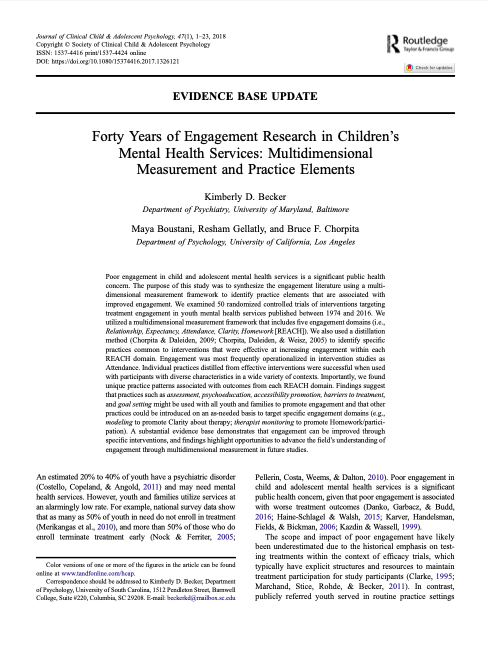Forty years of Engagement Research in Children’s Mental Health Services: Multidimensional Measurement and Practice Elements.

Poor engagement in child and adolescent mental health services is a significant public health concern. The purpose of this study was to synthesize the engagement literature using a multidimensional measurement framework to identify practice elements that are associated with improved engagement. We examined 50 randomized controlled trials of interventions targeting treatment engagement in youth mental health services published between 1974 and 2016. We utilized a multidimensional measurement framework that includes five engagement domains (i.e., Relationship, Expectancy, Attendance, Clarity, Homework [REACH]). We also used a distillation method (Chorpita & Daleiden, 2009; Chorpita, Daleiden, & Weisz, 2005) to identify specific practices common to interventions that were effective at increasing engagement within each REACH domain. Engagement was most frequently operationalized in intervention studies as Attendance. Individual practices distilled from effective interventions were successful when used with participants with diverse characteristics in a wide variety of contexts. Importantly, we found unique practice patterns associated with outcomes from each REACH domain. Findings suggest that practices such as assessment, psychoeducation, accessibility promotion, barriers to treatment, and goal setting might be used with all youth and families to promote engagement and that other practices could be introduced on an as-needed basis to target specific engagement domains (e.g., modeling to promote Clarity about therapy; therapist monitoring to promote Homework/participation). A substantial evidence base demonstrates that engagement can be improved through specific interventions, and findings highlight opportunities to advance the field’s understanding of engagement through multidimensional measurement in future studies
Full text available here: Becker et al (2017)



